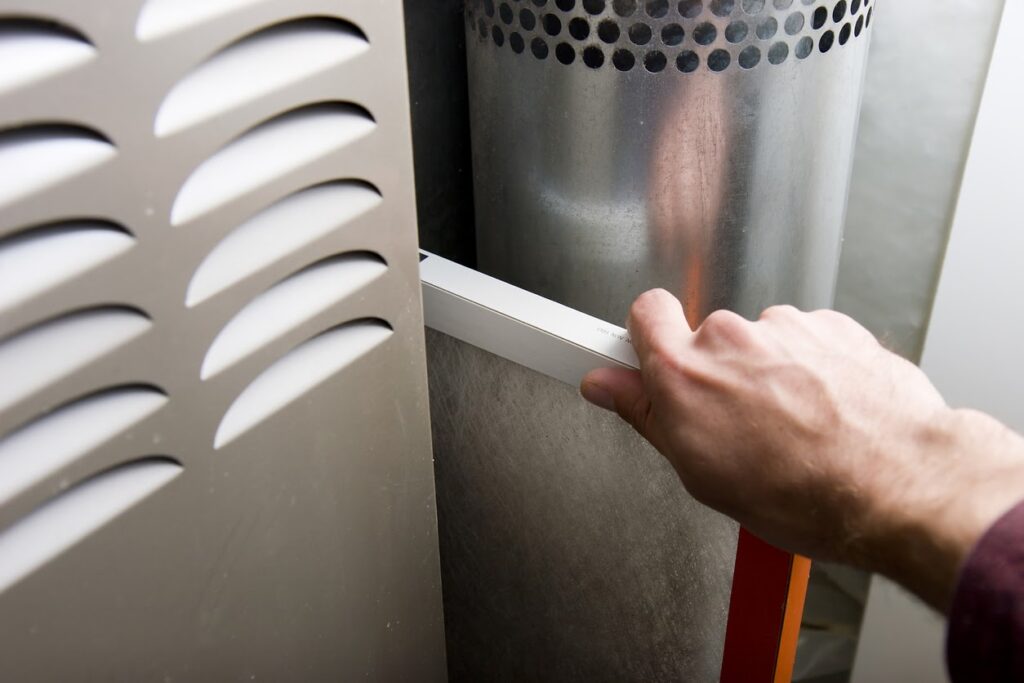There’s no worse feeling than waking up in the middle of the night to your entire house feeling like it’s a refrigerator. Let me guess, you usually fix this issue by pulling up the bedcovers and turning up your space heater. However, a cold house could mean that you’re having furnace problems.
Luckily, troubleshooting and fixing your furnace typically only requires a little elbow grease and some DIY experience. However, when it comes to more serious issues, make sure to call a professional. They can take care of the problem swiftly and efficiently. For more information on recognizing serious issues, read about common furnace repair problems and how to handle them.

Key Takeaways
- If you notice that your furnace is not working properly, first check the thermostat, then the breaker, then the air filters.
- If you can’t diagnose an easy fix to the problem, then you need to contact a professional furnace repair and maintenance company.
- Check your furnace regularly, change the air filters every three months, and schedule yearly tune-ups to make sure your furnace lasts a long time!
- Althoff Industries offers 24-hour emergency service to residents of Chicago and the surrounding areas. Call our emergency hotline number at (815) 455-7000!
Top 5 Furnace Issues to Avoid
Some of the most common furnace problems happen more frequently than others and, in some instances, are relatively easy to fix. Take a look at some of the most common furnace problems below.
1. Your Furnace Is Not Producing Enough Heat
Your furnace’s primary job is to circulate warm air throughout your home. While a furnace that is failing to generate heat is a cause for concern, the problem could actually be with your thermostat. In addition, dirty filters can prevent the flow of heat in your home. Check the thermostat or air filter to see if either one of them is the problem.
2. Your Furnace Is Repeatedly Turning On and Off
As your furnace heats your home, it typically cycles on and off to keep the temperature at the desired level. If you find that your furnace is repeatedly switching on and off or it is only working for a few minutes at a time, your problem may be a clogged filter.
3. Your Furnace Is Not Turning on Automatically
If all is well and good, your furnace will turn on and generate heat as soon as it receives a signal from the thermostat. However, if you’ve found that it doesn’t promptly turn on, try checking your breaker box. Flipping the furnace safety switch may solve the problem.
4. Your Furnace Just Plain Stopped Working
If your furnace isn’t heating your home at all, it could be a problem with your boiler or thermostat. If you can’t determine the issue, then you should call a professional to come repair or replace your furnace. Nobody wants to be stuck in the middle of winter with a faulty furnace!
5. Odd Noises Are Coming From Your Furnace
Any instances of squeaking, rumbling, scratching, or rattling noises coming from your furnace are all indicators of a mechanical problem. Most furnaces will create some slight noise, as they run continuously. However, if you notice anything that sounds blatantly noticeable, you should call an emergency furnace repair service to schedule an inspection. You might be hearing sounds described in furnace warning signs that indicate the need for professional attention.
Smart Furnace Maintenance Tips
While there are times when a furnace problem needs the attention of an experienced technician, in other situations, the problem might be something that could be prevented in the future. If you start to notice problems, run through these basic furnace troubleshooting measures to see if it’s a problem you can fix on your own.
Replace the Air Filters Every Three Months
A clogged filter can have a drastic impact on your furnace’s ability to do its job. Luckily, changing the filter is one of the easiest, albeit most important, maintenance tasks you can perform. Replacing the filter every three months can increase indoor air quality and extend the life of the furnace. If it’s been a while since you inspected the air filter, it may be a good idea to replace it with a new one.

Regularly Check Your Unit When It’s Not in Use
Even when not in use, power up your furnace at least once every season to ensure that it is working properly. Switching on the furnace will help you detect any underlying issues, such as excessive dust in the filters, which can restrict airflow. If you notice anything serious, then you should contact a professional.
Clean the Vents and Ducts
Ensure that all vents and registers are open and that nothing is obstructing the vents to ensure proper airflow and circulation in your home. Additionally, cleaning the ductwork will help keep the furnace running correctly and avoid potential damage.
Schedule Routine Maintenance With an HVAC Professional
Lastly, you should have an HVAC specialist inspect, test, and perform maintenance on your home heating system every year. Regular maintenance will help increase your furnace’s performance and prolong its lifespan. For detailed tips on how to keep your furnace safe and efficient, make sure to review seasonal care strategies recommended by professionals.
The Best 24-Hour Furnace Repair Service in Chicago
Althoff Industries has served the residents of Chicago and the surrounding areas since 1961. With our team of qualified and certified furnace repair technicians, we can inspect your furnace, diagnose any problems, and let you know what repairs need to be made.
If your furnace isn’t heating your home the way it should, or you think there may be another problem, give us a call today. One of our certified and reliable technicians will get your furnace back up and running in no time.
Call Althoff Industries’ emergency hotline number at (815) 455-7000. We’ll be there as soon as we can!








